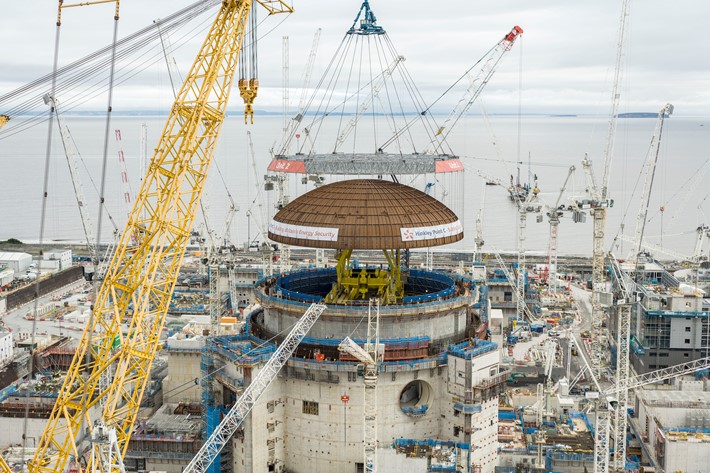"Big Carl", the world’s largest crane, has successfully placed the 245-tonne dome onto Hinkley Point C’s second reactor building.
It marks a major step forward for the power station’s identical second unit.
The 14-metre-tall dome closes the 44-metre-high reactor building, allowing its fit-out to accelerate.
Work on Unit 2 was stopped during the pandemic, but teams are catching up on lost time. Their progress is helped by innovation and experience from Unit 1, which means Unit 2 takes 20-30% less time to build.
The twin nuclear reactors will provide reliable zero-carbon electricity for more than six million homes, boosting Britain’s energy security for decades to come.
Although the second dome was lifted 18 months after the first, Unit 2 is further ahead, compared to the same moment for Unit 1.
Prefabrication in factories on and off-site is driving gains in productivity, safety and quality, with giant steel structures and complete rooms now being lifted in, making Hinkley Point C a Large Modular Reactor.
On Unit 2’s civil construction, 30% fewer people achieved 40% more work than on Unit 1 with prefabrication of structures now approaching 60%.
More equipment has been fitted and 300 tonnes of internal steel installed, versus just 10 at the same stage for Unit 1.
Innovation has allowed the massive concrete cylinder around the reactor to be built 40% more quickly.
EDF, which is building two new nuclear reactors at Hinkley Point C in Somersert, broadcast the lift on its YouTube channel.
Hinkley Point C is the first nuclear plant to be built in Britain for 30 years, restarting a supply chain and industry after a long pause. The figures highlight the benefits of building a series of identical plants. Innovation and experience gained at Hinkley Point C will benefit Sizewell C from the start.

Stuart Crooks, CEO of Hinkley Point C, said: “Restarting the industry has been hard, but the second of our two identical units shows the big benefits of repeating an identical design.
“Build and repeat is the best way to build new nuclear with time savings already at 20-30%. All our experience and innovation will benefit Sizewell C from the start.”
Energy minister Michael Shanks added: “Hinkley Point C will deliver the next generation of clean, homegrown nuclear power, creating high quality jobs and growth in Somerset and across its supply chains.
“The government is ending years of delays to usher in a golden age of new nuclear, with funding for Sizewell C and SMRs, protecting family finances and boosting our energy security.”
The update at Hinkley Point C came as government made further announcements for the nuclear sector, saying the UK will be the first country in the world to develop fusion-specific planning rules.
The plans will see fusion introduced into the Nationally Significant Infrastructure Project regime, putting fusion energy projects on the same footing as other clean energy technologies such as solar, onshore wind and nuclear.
Government says this will drive growth and unlock benefits for places such as Nottinghamshire, Oxfordshire and South Yorkshire where the fusion industry is already supporting thousands of jobs – revitalising industrial heartlands with the clean energy of the future.
Currently, fusion projects must submit an application to the local authority with no set timelines for approval and no guidance on which sites are appropriate – hindering the technology’s development in the UK.
The introduction of a National Policy Statement will provide clarity to developers and streamline the planning process for fusion, giving applicants clearer guidance on where and how quickly projects can be developed. This will give industry certainty, break down regulatory barriers and get projects built quicker to cement the UK’s position at the forefront of the global race for fusion.
The Spending Review recently delivered a commitment to invest more than £2.5bn in fusion research and development. This includes progressing with the STEP programme (Spherical Tokamak for Energy Production) which aims to develop and build a world-leading fusion power plant by 2040 in Nottinghamshire, creating thousands of new jobs with the potential to unlock limitless clean power.
Click here to watch the dome being lifted into place at Hinkley Point C.

